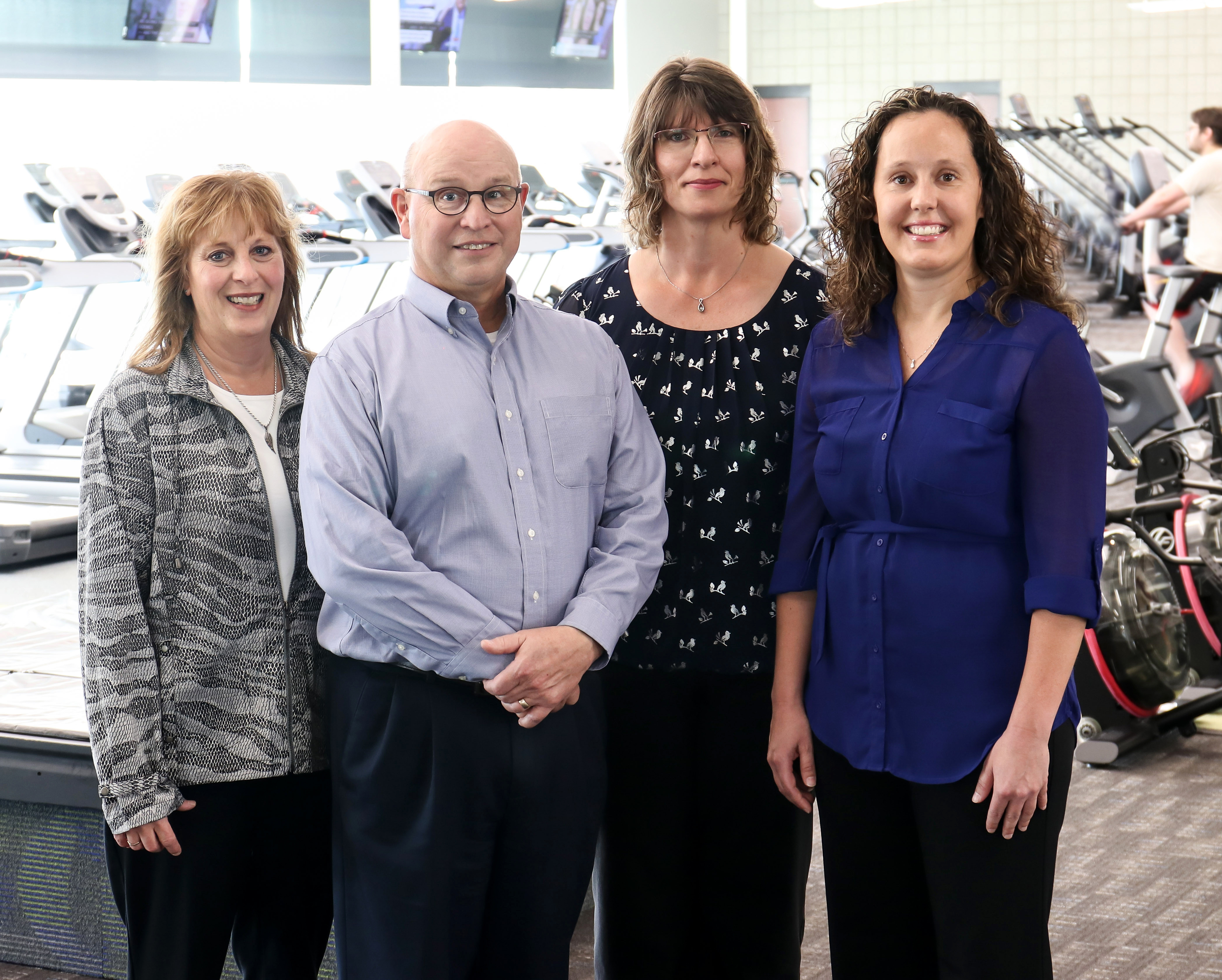Counting Your Blessings
Being in the right place, at the right time is considered lucky. But what about being in the right place, at the right time, with the right people and the right equipment? For Dr. Joe Blonski, that is what he calls a miracle —when a small group of people came together on a snowy day last January at the St. Cloud Area Family YMCA.
Dr. Joe Blonski, CentraCare Physician Vice President, Ambulatory Division and Population Health: It was the last Monday in January. I’d normally come into the office (CentraCare Administration) around four each morning and work until a little before five. I throw on my sweatshirt and head over to the Y and I’ll usually work out between 5 and 5:45 or so, and then shower and get back to work. On this particular Monday morning, I worked out for about 45 minutes.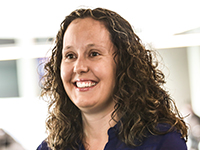
Rachel Appel, RN
Rachel Appel, RN, CentraCare ICU: I was pretty new to the YMCA as a member. There was a class at 6 a.m. that I had been taking for a month or so. I would attend a few days a week. Six a.m. was a good time for me because I could work out and get back home to get my kids to school.
Kari Dembouski, RN, CentraCare Employee Health: I am usually there every day during the week at 5 a.m. That morning I remember my husband saying the weather was bad (ice and snow) and that I should just skip the gym that day because we live an hour north of St. Cloud. There was something that told me I should go anyway — just to drive slow.
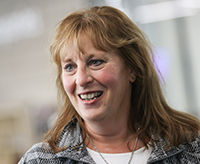
Karen Henning, RN
I always go on one of three machines in that room, so I was right next to Dr. Blonski. I was watching HGTV. I zone out while on the elliptical. I don’t look or watch anything around me.
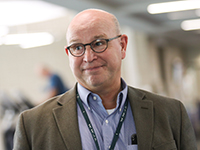
Joe Blonski, MD
Dr. Blonski: Although I was a little tired that morning, nothing else was going on. So as I got off the elliptical, I walked over and was just leaning down to grab my sweatshirt and felt a little dizzy. And that’s kind of the last thing I remember until I woke up.
Rachel: While waiting for my class, I had to grab a Kleenex from the bathroom. I was walking by the workout area.
Karen: I did not see him fall but a lady behind me saw him fall and yelled. At that point, I got off to help and so did my husband. I did not know who he was except for the guy who got there earlier in the morning and got my favorite elliptical.
Rachel: I heard people hollering for help. Being a nurse, I figured I should check things out. I really was just hoping he had passed out.
Karen: We rolled him over, carefully supporting his neck. I just thought he vasovagaled (fainted) and occluded his airway (blocked his breathing) when he collapsed or possibly hit his head.
I did a jaw lift and he seemed to be breathing. Someone went to call for help. He was very diaphoretic (sweaty) so we decided to take his sweatshirt off. I remember supporting his neck while we turned him to get it off and then he stopped breathing.
Rachel: First, I called 911 when I noticed he needed help. While on the phone it was apparent that he needed CPR. I handed over the phone and initiated CPR.
Karen: We checked for a pulse and there was none. A nurse from Employee Health Services [Kari] helped with CPR and, at the same time, someone brought me an AED.
Kari: At the time of the event, I did not recognize him. I know who he is, but I didn’t even think about it — I was just trying to help him.
Rachel: I suggested we put the AED on just in case. Karen opened the AED and put it on him. I had never used one except in a class.
Karen: I put patches on, just wiped off his skin with my shirt.
The biggest struggle I remember was opening the package. I used my teeth, because I couldn’t get it open. And then I remember looking up at Rachel, an old coworker from ICU, and I remember saying “I don’t know which button to push!”
And she said, “I think it is this one, Karen.” So, I called for a stop in CPR to analyze.
Rachel: When the AED advised a shock, I realized that the situation was serious.
Kari: I prayed that he would pull through.
Karen: So, I did the “I’m clear, you’re clear, we are all clear” and shocked.
Rachel: I resumed CPR.
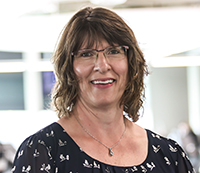
Kari Dembouski, RN
Kari: I helped get the mask ready and then took over for compressions. I was doing compressions when I noticed his eyes fluttering and that we should stop CPR and check for pulse at which time he started to breathe and move.
Rachel: Everything happened very fast. It was probably all less than five minutes.
Kari: We tried to roll him on his side, but he didn’t want to stay there. He wanted to sit up.
Dr. Blonski: So they shocked and I woke up which is pretty cool because it normally doesn’t happen that way. I woke up and wanted to sit up and I remember somebody kind of pushing me to stay down and I wanted to say, “Just let me sit up!” but I couldn’t. The words wouldn’t come out for about 10-15 seconds.
Rachel: I was completely in shock. It was amazing how quickly he came around. At first, he was a bit confused, but after a few minutes he knew what was going on. The whole situation felt like a whirlwind.
Kari: I was so happy and in disbelief. I was surprised that he wanted to sit up.
Dr. Blonski: I sat up against the window and the police had just gotten there, so they were asking a bunch of questions and all of which was stuff I knew: what’s your name, your wife’s name, your phone number. I knew everything right away so there was no loss of memory or anything.
Rachel: I did not know who he was. Afterwards, Karen and I were talking about everything and his friend walked up to tell us who he was. We both had no idea.
Karen: After the incident, I went to work. Someone asked me about the police cars and ambulance at the Y and I said, “Well, I shocked someone,” and went on with my day.
Dr. Blonski: (Dr.) Tim Ebel, one of the hospitalists, just happened to be over at the Y that morning. He saw the commotion and came over and sat down. I said, “Hey, can you take me over to the hospital?”
And he said, “Joe, you just had a cardiac event. No, I can’t. You have to go by ambulance.”
I said, “I knew you were gonna say that,” but he goes, "I’ll take your car over." And I said, “By the way, can you give my wife a call? I don’t have my phone with me.”
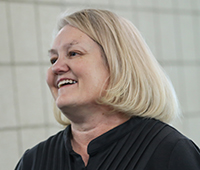
Patty Blonski
Patty Blonski, Joe Blonski's wife: There was a snowstorm overnight and this was the one day I turned off my phone because Joe was going to call me and leave a message letting me know about the roads. I didn’t want it ringing and waking me up early in the morning.
Dr. Blonski: EMS got there at the Y and everything was fine — vitals were fine, EKG looked fine. So they took me over to the hospital and when we got to the ER, (Dr.) Mark Hoffman was there. Mark just so happens to be my neighbor and he’s getting off work so I asked him “Before you swing by your house, can you swing down to my house and see if you can ring the doorbell, get my wife out of bed and let her know what's going on.”
Patty: When I woke up, I turn on my phone and there’s all these messages. As soon as I figured out what was going on, I jumped into some clothes and opened my garage door to leave. And there, on the other side of the door, standing in the dark, is my neighbor Mark. He scared me to death.
Dr. Blonski: I was admitted to the hospital and cardiology said they needed to take me to the cath lab.
Patty: I get to the hospital, and I’m walking down this long dark hallway and I hear people laughing in a room. I open the door and he’s talking with someone and they’re laughing and carrying on.
Dr. Blonski: At the cath lab, we learned that I had a 95 percent blockage in my left anterior descending artery. It’s commonly called "the widowmaker."
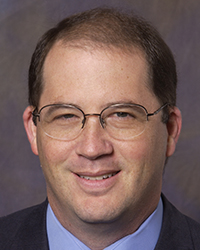
Richard Jolkovksy, MD
Dr. Richard Jolkovksy, CentraCare Heart & Vascular Center Cardiologist: This is an important blood vessel and has a large amount of heart muscle downstream. So, when the artery is blocked there is the potential of a lot of damage to the heart. Dr. Blonski didn’t have a lot of warning symptoms.
Patty: When I saw him in the room, it didn’t seem right. It seems like there should be more urgency. And then I recognize a bunch of the people in the room because just a few months earlier we were at a conference with them and spent an entire week together.
Dr. Jolkovksy: It can be emotionally challenging caring for colleagues. Being the only Heart Center in our region, we are used to treating colleagues, friends and acquaintances. This keeps the importance of what we do very much at the forefront of our minds.
Patty: They’re talking about going to play a golf course in California while they’re putting the stent in.
Dr. Blonski: I was up walking by that evening and walked out the door the next day at noon.
Dr. Jolkovksy: For Joe, everything came together to allow it. First, he didn’t actually have what we would call an ST Elevation MI (STEMI). His artery was severely narrowed but not totally closed, and his heart function remained normal without damage.
Dr. Blonski: I wanted to return to work the next day, but they wouldn’t really allow me. So, to appease my wife and my cardiologist and my coworkers, I didn’t return to work until the following Monday.
Dr. Jolkovksy: He had been treated rapidly with CPR and defibrillation with an AED, so he did not have significant injury to his other organs such as brain, kidneys or lungs.
Dr. Blonski: God had me in the right place at the right time, the right people and the right equipment. I was blessed by that.
Every second counts!
Be prepared to save a life if someone suffers cardiac arrest near you.
• Review callpushshock.org to learn how immediate CPR and use of an AED can make a difference.
• Learn how to perform CPR on an adult or child from mayoclinic.org
Patty: When I reflected on that day at the hospital, all I could think was God had this all in his hands. I really feel like these ladies were there for a purpose. It was a symphony of them working together.
Rachel: I expected the worst when I was at the Y. It was amazing to see what quick action and use of an AED can do.
Dr. Blonski: You don’t have to be a doctor or a nurse to use it. Anybody can get that out and hook it up. To me, it is about timing. I was waking up by the time the EMTs got there, I knew everything that had happened, where I was at, what was going on. They had done excellent CPR and they shocked me quick enough for my rhythm to return and to not lose any blood flow to the brain.
Dr. Jolkovksy: Dr. Blonski’s being shocked by an AED was one of the key factors to him having a good outcome. The rest of the care would have been irrelevant if bystanders had not treated him with CPR and rapid defibrillation with the AED.
Kari: AEDs should be made available to all areas of the community. If a church or other group needs one, they should be able to get one and send members for training.
Patty: Don’t let it ever be said that miracles don’t still happen because they do.
Dr. Blonski: I’m not sure why God thinks I still need to be around and hanging out. I’m ready to go whenever he wants to take me home, but he obviously believes that I should still be here for some reasons. My job now is to kind of try to figure out why and make sure that my eyes and ears are open to the things that he wants me to be doing.
